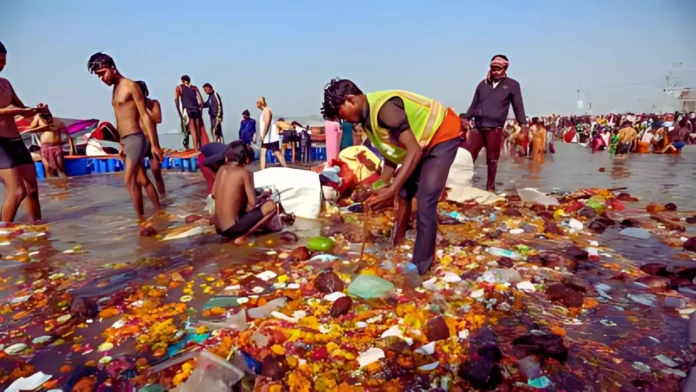New Delhi [India]: Amid concerns over a recent report highlighting increased fecal coliform (FC) levels in the river at Prayagraj, experts have stated that more data is needed to determine the actual condition of the water. However, some believe that the water at Triveni Sangam remains fit for bathing.
Professor Umesh Kumar Singh from the Centre of Environmental Science at the University of Allahabad suggested that the water quality, based on dissolved oxygen levels, was good.
“The level of dissolved oxygen in the water, as shown in the report, is good… On the basis of the current data, I can say that the water at Triveni Sangam is fit for taking a bath,” Singh told media.
Singh also pointed out that the report by the Central Pollution Control Board (CPCB) was incomplete, lacking crucial data on nitrate and phosphate concentrations.
“A few days back, the CPCB prepared a report that stated increased levels of fecal coliform (bacteria) in the water. I believe that the CPCB needs to work more on the report because their data is not complete… The concentration of nitrates and phosphates needs to be indicated, we can tell that the water has sewer water present. When I analysed the data, I thought that these data were missing,” he said.
Associate Professor RK Ranjan from the Central University of South Bihar echoed similar concerns, stating that the existing data was insufficient to conclude that the water at Sangam was unsafe for bathing.
“Central Pollution Control Board data is very inconsistent. To conclude that water is unsafe to bathe in would be to say things in haste. There is not enough data to conclude that the waters in Prayagraj are not safe to bathe in,” Ranjan told ANI.
He also noted that various factors, including large crowds bathing in the same waters, could contribute to temporary increases in bacterial levels.
“Similar data can be seen from Garhmukteshwar, Gazipur, Buxar, and Patna. There could be many reasons for this to happen. One reason behind this is that a large number of people bathe in the same waters. It also matters from where and when the sample of water is taken,” he added.
Assistant Professor Amit Kumar Mishra from the School of Environmental Sciences at Jawaharlal Nehru University (JNU) emphasized the need for more comprehensive data.
“I would say we need more data sets; we need more measurements…There is a huge number of population which is taking a bath (at Mahakumbh). If you talk about the coliform bacteria, it is nothing new…If you look at the data of the Shashi Snan peaks, you will see the E. Coli bacteria peaks at that time. So, in conclusion, I would say that we need more data sets, more parameters, and more monitoring stations, especially downstream,” Mishra told ANI.
He also noted that a concentration of three micrograms per litre was considered safe for bathing.
“For bathing purposes, three micrograms per litre is safe, and we can say that the water is good for bathing. But if you see the variation in the data of the Sangam ghat, you will see that it is fluctuating around 3. Sometimes, it goes 4, 4.5. So I would say that the dissolved oxygen level we see is a sign of a very healthy water body, and also, if you look at the pH range, they are all alkaline water,” he explained.
Meanwhile, Uttar Pradesh Chief Minister Yogi Adityanath dismissed concerns regarding fecal contamination at Triveni Sangam. He assured that continuous monitoring and purification efforts were in place to maintain water quality.
Addressing the state Assembly, he said, “Questions are being raised about the quality of the water (at Triveni)… All the pipes and the drains in and around Sangam have been taped, and the water is being released only after purification.”
CM Adityanath also emphasized that the Uttar Pradesh Pollution Control Board (UPPCB) is regularly assessing water quality at Sangam.


